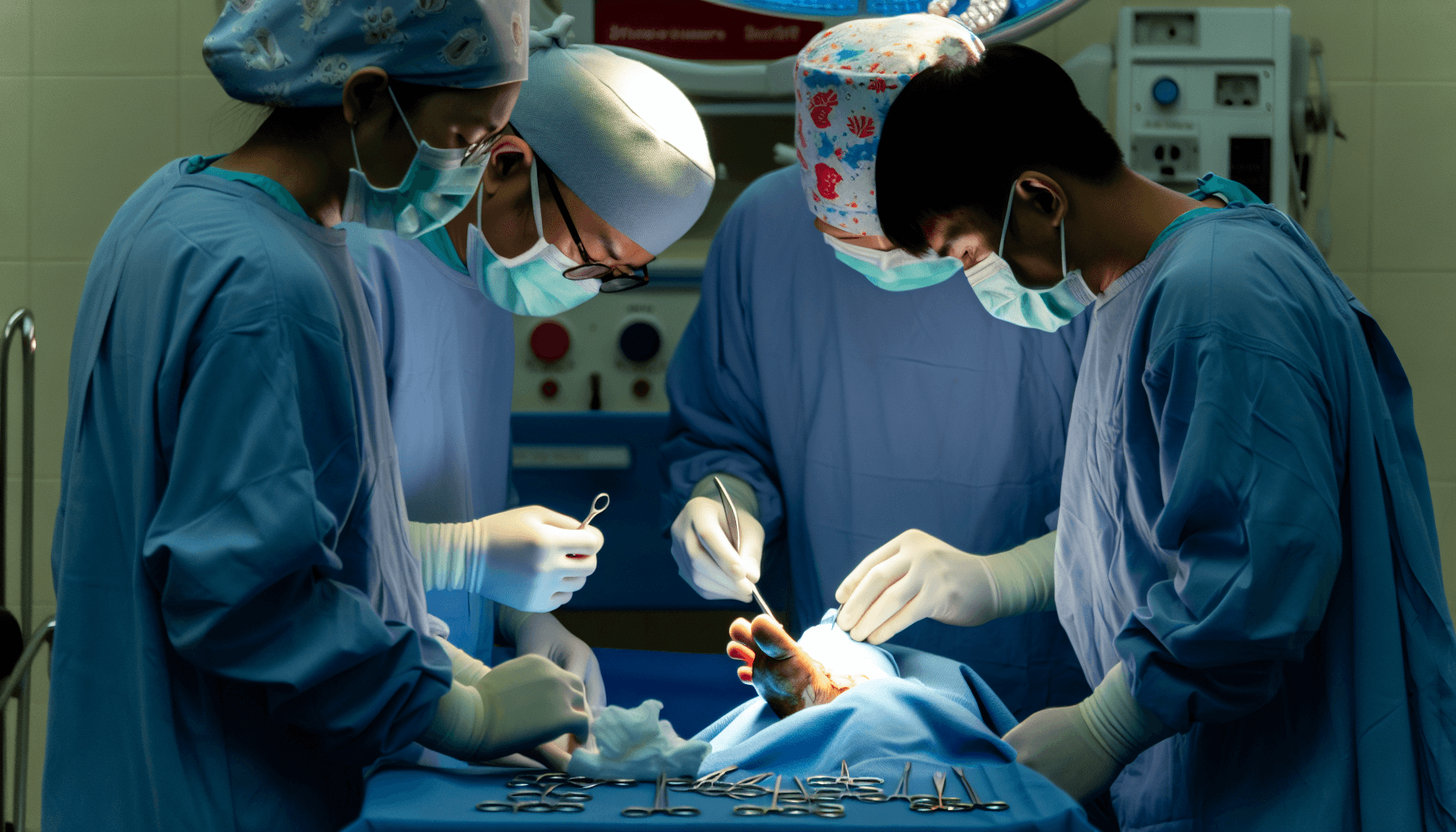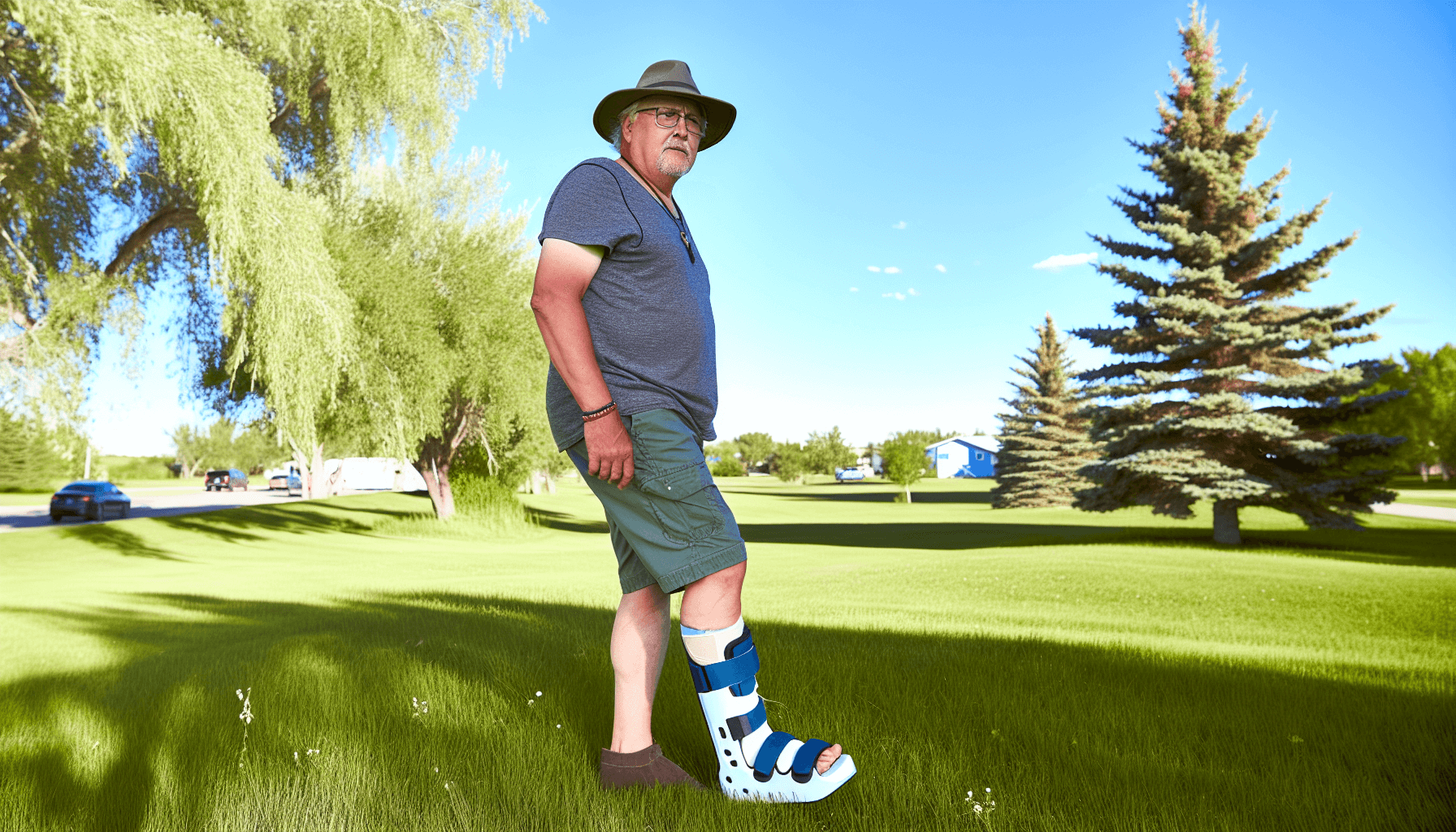Flat Footed Surgery: A Comprehensive Guide to Outcomes and Recovery Time


Are you considering flat footed surgery due to unresolved pain and arch issues? This article will guide you through the necessity of the procedure, what happens during surgery, and what recovery entails, helping you make an informed decision on whether surgical intervention is the right course for you.
Key Takeaways
Flat feet, or pes planus, can be caused by several factors including obesity, injury, arthritis, aging, and diabetes, and the condition is diagnosed usually through a physical exam.
Surgery for flat feet is considered when non-surgical treatments like rest, orthotic devices, and exercises fail to alleviate pain and improve quality of life, with the patient’s overall health and severity of symptoms being critical factors for determining suitability for surgery.
Recovery from flat foot surgery is an extensive process lasting six to twelve months, with risks including arthritis, deformity recurrence, nerve damage, and infection, but physical therapy plays a crucial role in functional recovery and optimal long-term outcomes.
Understanding Flat Footedness
Medically known as pes planus, flat feet are characterized by the absence of a normal arch when standing, affecting the heel bone. Various risk factors such as:
obesity
foot or ankle injury
rheumatoid arthritis
aging
diabetes
contribute to this condition. It might even be hereditary, stemming from congenital abnormalities, tendon injuries (like the Achilles tendon), fractures, or nerve damage.
Diagnosing flat feet involves a physical examination. A podiatrist would assess for signs of flat feet and may ask you to stand on your toes to evaluate your foot structure.
Evaluating the Need for Flat Foot Reconstruction Surgery
While flat feet can be a nuisance, not every case requires surgical intervention. The need for surgery hinges on the severity of discomfort, the impact on daily activities, and the effectiveness of non-surgical treatments.
We will further examine the conditions under which minimally invasive surgery, including reconstructive surgery, becomes a practical solution.
When Non-Surgical Treatments Fall Short
Non-surgical interventions for flat-footedness include:
Rest
Ankle braces
Shoe inserts
Anti-inflammatory and pain medications
Orthotic devices
Stretching exercises
These treatments provide significant relief for many, helping to relieve pain. However, they might fall short for some due to genetic predisposition, inadequate muscle response to treatment, or non-compliance.
What is the next step when conservative treatments do not alleviate the symptoms? Persistent pain, inflammation, and discomfort that continue despite non-surgical treatments may warrant a more definitive, surgical correction for long-lasting relief. Should symptoms persist and impede the patient’s quality of life after a substantial period of non-surgical treatments, the recommendation may lean towards surgical intervention.
Assessing Your Suitability for Surgery
Determining your suitability for flat foot surgery is a multi-faceted process. Your overall health plays a pivotal role. Factors such as smoking can hinder healing, while obesity can increase the risk of blood clots and wound complications. It’s also worth noting that there’s no designated age limit or prerequisite for flat foot surgery. You can undergo the procedure at any age provided you’re a suitable candidate based on other health and foot condition factors.
The severity of symptoms like:
persistent joint pain
hind foot deformity
muscle weakness
paralysis
combined with your functional demands and lack of improvement from conservative treatments, can make you a candidate for surgery. So, it is not just about whether you have flat feet, but how your flat feet are affecting your life.
The Surgical Journey: From Operating Room to Recovery
Embarking on the surgical journey comes with its own set of expectations and fears. The process of flat foot reconstruction surgery, from the operating room to recovery, is a journey in itself.
We’ll examine the various stages of this journey.
In the Operating Room: What Happens During Flat Foot Surgery?

Flat foot surgery, also known as flat feet surgery, which may sometimes involve ankle surgery, is conducted under regional or general anesthesia and is not a one-size-fits-all procedure. It typically involves:
Repair of loose tendons
Realignment of the bones in the foot, often through procedures such as joint fusion surgery
In some cases, a tendon transfer - transferring the flexor digitorum longus tendon (FDL) to the posterior tibial tendon (PTT) to provide support to the arch of the foot.
Patients are advised to prepare for the surgery:
Adhere to a nutritious diet
Engage in regular exercise
Consider reducing or quitting smoking
Supplement with vitamin C for a period of 6 weeks prior to the surgical procedure
The surgery aims to address the collapsed arch of the foot through the repair of the supporting bones, ligaments, and tendons.
Post-Op Care: Navigating the First Weeks

Once the surgery is complete, the journey towards recovery begins. The first few weeks are critical. Following surgery, the foot is usually immobilized in a plaster cast for up to six weeks. Rest, elevation of the foot, and refraining from bearing weight are crucial to promote optimal healing during this period.
After about six weeks, the plaster cast is replaced with a removable boot. This transition allows for more mobility and is a significant milestone in the recovery journey. However, it’s important to remember that despite the boot providing more flexibility, rest and recovery should remain a priority.
Long-Term Recovery and Physical Therapy

Recovering from flat foot surgery is a long-term process rather than a quick fix. The complete recovery period can extend up to six to twelve months. However, each step forward brings you closer to a life free from flat foot discomfort.
Physical therapy plays a key role in this long-term recovery process. It aids in achieving correct walking patterns, minimizing swelling and muscle tightness, fostering healing, and enhancing range of motion. The exercises integrated into physical therapy may comprise:
Heel stretches
Tennis/golf ball rolls
Arch lifts
Calf raises
Stair arch raises
Towel curls
The goal of all these exercises is to enhance overall foot function by reducing pain, redistributing weight more evenly, and enhancing foot alignment.
Risks and Potential Complications of Flat Foot Surgery
As with any surgical procedure, flat foot surgery comes with its own set of potential risks and complications. While these are rare, being aware of them can help you make an informed decision. The prevalent complications of flat foot surgery encompass:
Adjacent joint arthritis: the cartilage that cushions the joints wears away, causing the bones to rub against each other. This can lead to pain, stiffness, and loss of movement in the joint.
Recurrent deformity: the foot reverts back to its original flat state.
Rigidity: the stiffness or inflexibility in the foot that can occur after surgery. It is a condition where the joints in the foot lose their normal flexibility, often as a result of scar tissue formation.
Nonunion: the failure of a fractured bone to heal properly after a surgery or treatment. This can occur when there is insufficient stability, blood flow, or both, preventing the bone from growing back together. Nonunion can cause persistent pain and may require further surgical intervention to rectify.
Nerve or blood vessel damage: This is a potential risk in any surgery. Nerves and blood vessels may be accidentally damaged during the procedure, leading to numbness, tingling, or loss of blood flow to certain areas of the foot.
Persistent pain
Blood clots
Infection
The risk of infection following flat foot surgery is approximately 1%, and if it occurs, it can typically be effectively treated with antibiotics. Factors that can impact the bone healing process following flat foot surgery include:
Blood supply
Biological environment
Inadequate blood supply
Biomechanical instability
Immunosuppression
Smoking
Some patients may experience discomfort due to prominent hardware after flat foot surgery. Being aware of these risks is not meant to deter you from surgery, but to ensure you are fully prepared for all potential outcomes.
Life After Flat Foot Surgery: Expectations vs. Reality

Life after flat foot surgery can be a game-changer. With success rates ranging from 80% to 98%, this surgery has the potential to alleviate pain and restore function. Here’s what you can expect:
You can expect to resume moderate activities within several months.
Full weight bearing of the foot typically occurs at 6 weeks.
Return to sports is possible within three to six months.
However, it’s not just about the numbers. The reality is that each person’s journey is different. Following the surgical procedure, it is possible for patients to notice swelling, bruising, and alterations in color in the foot. However, it’s crucial to remember that the main goal of the surgery is not aesthetic improvement, but to correct the foot alignment, which in turn promotes a balanced weight distribution while walking or standing.
Alternatives to Traditional Flat Foot Reconstruction
While we’ve primarily discussed flat foot reconstruction surgery, it’s not the only solution. Minimally invasive surgical techniques, such as HyProCure, subtalar extra-articular screw arthroereisis (SESA), and Mini-BEAR (bone extra articular reconstruction) offer alternatives to traditional surgery. These methods offer benefits such as quicker healing, reduced scarring, and decreased stiffness when compared to traditional surgery, which may involve the medial cuneiform bone. Learn more about that different types of foot surgeries.
Non-surgical treatments for managing flat feet include:
Rest
Ankle braces
Shoe inserts
Anti-inflammatory and pain medications
Arch supports
Stretching exercises
Physiotherapy
Orthotic devices
Non-permanent treatments aimed at relieving symptoms, such as advice and education, footwear, arch supports, and orthoses, have shown to be beneficial in reducing pain and disability associated with flat feet. To treat flat feet effectively, keep in mind that the most suitable treatment for you will depend on your unique circumstances and should be discussed thoroughly with your healthcare provider.
Ready Set Recover: A Game-Changer for Flat Foot Surgery Patients
Ready Set Recover is an invaluable resource for individuals who decide to undergo flat foot surgery. This program provides a framework tailored to optimizing the surgery journey. Here are some of the benefits:
Expert Guidance: Patients have access to expert advice and guidance throughout their recovery journey, which can help alleviate any fears or uncertainties they may have about the process.
Emotional Support: The recovery process can be emotionally challenging. Ready Set Recover offers emotional support to help patients stay positive and motivated throughout their recovery.
Education: Ready Set Recover educates patients about navigating the recovery process, empowering them to take an active role in their recovery.
Ready Set Recover can significantly enhance the recovery experience for flat foot surgery patients, helping them return to their regular activities as quickly and safely as possible.
Summary
From understanding flat footedness to exploring surgical interventions and alternatives, we’ve journeyed through a comprehensive guide to managing flat feet. The road to relief from flat foot discomfort may seem long and daunting, but remember, each step you take brings you closer to a more comfortable and active life. Don’t let flat feet hold you back. Take that first step towards recovery today.
Frequently Asked Questions
Can flat feet be corrected with surgery?
Yes, flat feet can be corrected with surgery by repairing loose tendons or realigning the bones in the foot, depending on the severity of the condition. Joint fusion surgery, known as arthrodesis, is one of the possible procedures.
What age is best for flat foot surgery?
Flat foot surgery is typically best for children after their foot has fully developed, usually around age 8 or 10. Surgery is recommended only if the child continues to experience pain despite conservative treatments and other conditions have been ruled-out.
How successful is flat foot reconstruction surgery?
Flat foot reconstruction surgery, also known as Subtalar joint arthritis surgery, has a 98% success rate, making it an effective procedure for treating flat foot.






